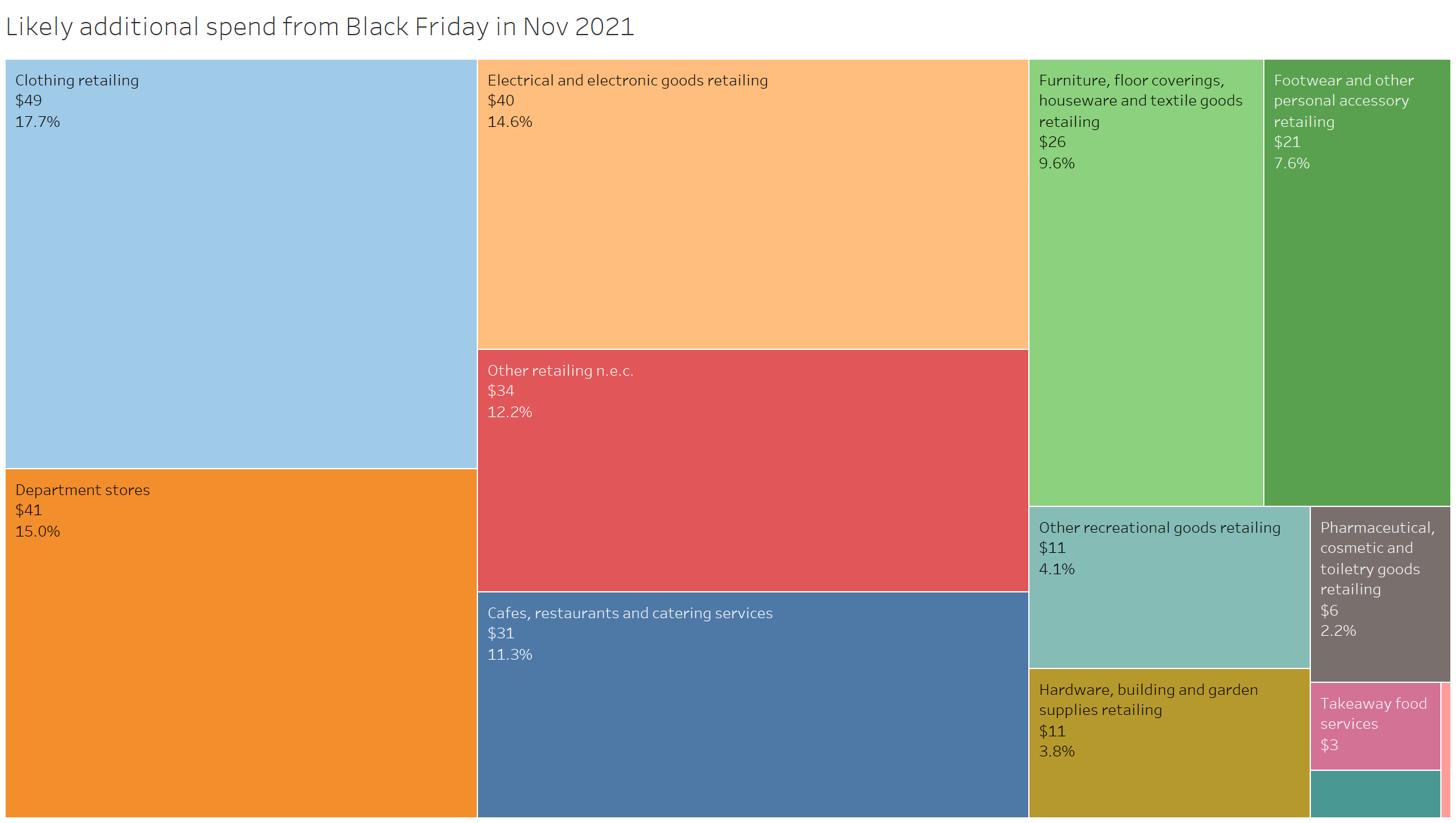Black Friday: Big deal or no deal?
Black Friday (25th Nov) is a global event and something consumers and retailers look forward to every year (well, from an Australian perspective, from 2018).
And rightly so, as there are big savings to be had and lots of money to be made, mainly in the online world but this does filter into bricks & mortar.
So, let’s just set the scene with what this means.
Using the ABS’ retail data, we can see the expected lift at the end of each year, before the natural Christmas mayhem.
Your eyes may well be drawn to the April 2020 drop but that’s very explainable due to the Covid lockdowns.
Now, let’s isolate Nov and compare to the previous three months (Aug to Oct) to understand how much Nov increases. Keep in mind that there are some big events in November - Click Frenzy (8th to 10th), Black Friday (25th) and Cyber Monday (28th), so the uplift is a combination of these but for simplicity, we’re focusing on Black Friday.
We now have an “uplift” dollar value i.e. the additional amount spent vs our “normal”, which is the previous three months.
When we break this down by retail sector, we can see where the Black Friday magic happens! Note that we’ve focused on 2012 to 2019, as things get interesting when we include the last two years.
So, department stores dominate the uplift, with other retailing n.e.c (all other retailing) and Electrical goods creating sizeable uplift chunks.
When we bring in 2020 and 2021, we see a shift spend! Covid caused many issues but a lack of spending in retail wasn’t one of them. Retailers fanatically digitised their offerings and we can see the impact it had.
If we focus on the last 3 years, we can see how much Electronic goods and Clothing retail have really taken advantage of Black Friday and look to be outpacing Department stores for uplift.
Why is this happening?
Appliances and apparel have the biggest margins so they can offer the biggest discounts but they’re also positioned well for the digital transformation era that they were forced into thanks to the pandemic.
These are all pretty big numbers, so what does this all mean to me?
Well firstly, we’re spending a lot more than we did previously. Up to 2019, people we spending an extra $100 each on Black Friday. In 2020, that double to almost $200 and last year it was up to $261 extra.
And what exactly are we spending it on?
Well, the craziness of seeing sale signs everywhere means you’re likely to spend $49 at the Iconic (what a lovely a nice new t-shirt), $41 in Myer (summer is just round the corner, those swimmers look great) and $40 in JB Hifi (I always wanted a spy at home personal assistant at home).
So, it’s all good news then?
Perhaps not, as spending an extra $261 on sale items that you potentially didn’t need (read The Art of simple living by Shunmyo Masuno), the money has to come from somewhere and 2021, a small proportion of this money likely came from the Grocery budget, which saw a negative swing against prior 3 month period, the first time since 1998.
So is it worth it?
What are the long term impact of these massive sales? We talked with Danny Phillips from Omneo, who has the inside knowledge on just how many of the acquired Black Friday customers are extremely low value. Below are a few of our discussion points:
Not your best customers
A high proportion of any new Black Friday customers will be one off i.e. they’ve bought with you at a discount and that’s that, no further purchases. If the margin was low, then the return on investment will be minimal or even negative.
Returns are huge
Up to 40% of sale items will be returned and with free shipping and returns, that’s a massive cost.
Marketing databases skewed
For the marketers and CRM teams, Black Friday offers a way to inject huge numbers into a marketing program but a decent proportion are likely to be low engagement, fast unsubscribers that will skew KPIs.
Internal resource wasted
The likelihood is that internal resource have been working for months on Black Friday, getting things prepared and placing other projects on pause. The clever companies will have thought about the 90 days post Black Friday, finding a way to engage these new customers and get them to their next purchase, increasing the customer lifetime value.
Patagonia who are known for taking a integrity stance on most things and have actually shut their store on this day and if they are open, they’ve given all revenue to charity.
Massive opportunity
Let’s not be too pessimistic about Black Friday though. It is a huge deal and can create a massive boost to companies for brand awareness, revenue and customers. It just needs good planning, combined with data capture and a nurture program.
If you’d like to understand how Omneo could help your retail company provide exceptional customer experience (on & offline), then reach out to them here.
We specialise in data visualisation at White Box
We can help illuminate your data so that you can make the right, unbiased decisions for your organisation.
As your partner in data visualisation, we’ll help you to realise the full potential of your data and maximise your business success through advanced and innovative solutions that make all the difference.
Get in touch today for your free data strategy consultation.












